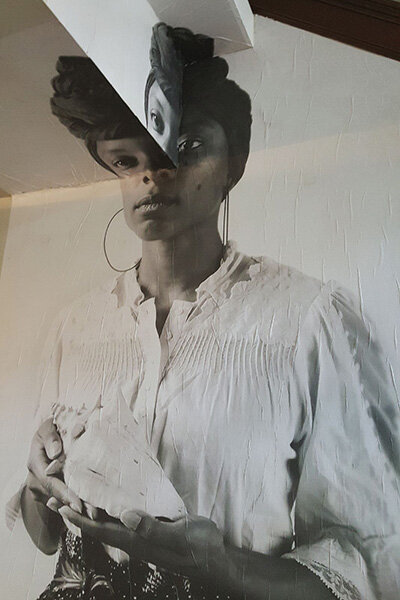The Moment We’re In: Art Basel Miami 2017 Begins
Now in its sixteenth year, Art Basel Miami Beach and its satellite art fairs stretch from North to South Beach, scattered in hotels, museums, tents, temples and domes everywhere from the beach to the sky. Over several days of openings, asados, open studios, performances, club events, and free cocktails, the expected guests — 70,000 international visitors — descend upon South Florida to make it rain, spending millions or billions of dollars on hotels, restaurants, and — of course — artwork. Trickle-down economics are in full stream as pop-ups and food trucks make out like bandits, and blue-chip buyers, curators and collectors from every part of the planet promise to make somebodies out of nobodies overnight.
So far, I’ve missed three pre-Basel events including a “procession to unveil a dome”, an installation that “emits mist-filled blossoms”, then another unveiling, but of a Jade luxury tower. Overwhelmed by the thought of it all, I could use some smelling salts, but Ruinart champagne for breakfast might do the trick. First stop: A press welcome breakfast (featuring said champagne) at the Botanical Garden before heading to the main fair’s VIP opening and DesignMiami. Then, to pen my story and sleep like a princess at that cultural oasis on the beach, the Betsy Hotel. Somewhere amid all that I’ll have to fit in a dinner at the Drunken Dragon, which means I risk missing Franchise Freedom, an “aerial sculpture” in which hundreds of brightly-lit drones imitate a flock of starlings. Panic attacks!
Claudette Schreuders, Hair, 2017, Jelutong wood, enamel, and oil paint, 49 x 24 x 15 cm. Image courtesy of Stevenson.
At the welcome breakfast, Art Basel Miami Beach director Noah Horowitz pointed out that the fair has abandoned its former “Basel pink” theme for something apparently “Tropicalismo,” and went on to more insightfully mention that the fair this year is full of “art that responds to the moment that we are in.”
“The moment we are in.” Let that sink in: Art Basel Miami Beach 2017 is happening in the midst of the #metoo movement. We are in a time of cultural upheaval, and this moment’s energy is palpable everywhere: In every booth, in every capsule event, and in every mist-filled bubble. It wasn’t only the Guerrilla Girls confronting the elephant in the room this time: American museum directors are finally blushing over their obvious underrepresentation, hurriedly drafting women’s initiatives and pledging to emphasize the creative voices of women artists. Until this moment, with little exception — and tragic consequences — women artists had been forgotten.
Nandipha Mntambo, Veiled Desires 1, 2017, cowhide, resin, polyester mesh, waxed cord and steel frame, 227 x 180 x 38cm. Image courtesy of Stevenson.
In step with the times, the current iteration of Basel has numerous galleries showing work by women artists. South Africa’s Stevenson features powerful works by four Southern African women, including Nandipha Mntambo. She is the subject of a survey at the new Zeitz Museum of Contemporary African Art in Cape Town, also known as “Africa’s MoMA” as it is the largest contemporary African art collection on the continent. Mntambo’s abstract sculptures, created from Nguni cow hides, are juxtaposed with figurative sculptor Claudette Schreuders painted wooden figures, and Zimbabwean Portia Zvavahera’s free-form paintings are contrasted with Zanele Muholi’s photographs from her renowned Somnyama Ngonyama self-portrait series.
Zanele Muholi, Kodwa, I, Amsterdam, 2017, Silver gelatin print on paper, 60 x 40cm, Edition of 8 + 2A. Image courtesy of Stevenson.
Back the Betsy Hotel on Ocean Drive — that rare gem on the beach — their gallery space is showcasing Milan-born artist Paola Cassola’s photographs, and multimedia artist Eurydice’s cinematic collages inhabit The Conservatory. Projected on The Betsy Orb, Mikhaile Solomon’s PRIZM features a selection of work by international artists from the African diaspora and beyond. Their beach debut features projected images curated by Solomon appearing between dusk and 11PM each night during the run of the fairs, a feature Vice President for Marketing and Philanthropy Deborah Briggs considers a “canvas” for the hotel.
Installation view of PRISM on The Betsy Orb, curated by Mikhalle Solomon. Image courtesy of the author.
Far downtown in a former post office, visual artist Anja Marais’s installation Out of Sight; Out of Mind taps into the zeitgeist with large paste-up portraits of immigrants that play with dual perspectives, twisting sight to examine peripheral views of human history. Her images are pasted into corners and archways in the gutted downtown building, creating warped faces that recall distorted views of immigration and its role in history. Marais photographed Miami Haitians who are the children of immigrants. They sat for her portraits and posed as their immigrant ancestors, each holding a tool of their trade.
Installation view of Out of Sight; Out of Mind by Anja Marais. Image courtesy of the artist.
It takes serious skill to navigate RSVPs for three simultaneous events, followed by four intimate invite-only dinners, all hosted on exclusive hotel rooftops, all at the same time, night after night, but that’s what the United States’s biggest art show is all about: Showing up and showing off. So off I go, into the night.





